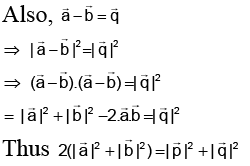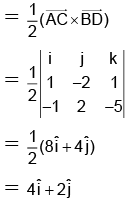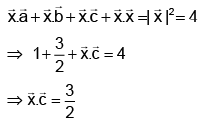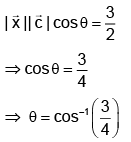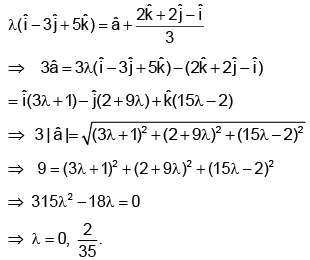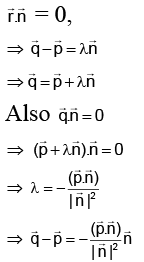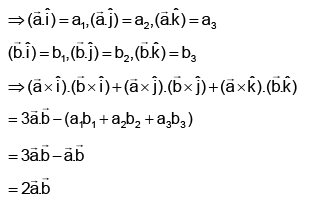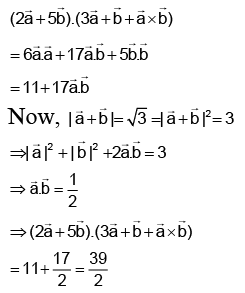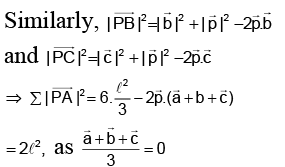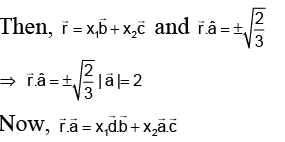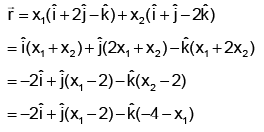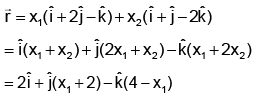JEE Advanced (Single Correct Type): Vector Algebra | Chapter-wise Tests for JEE Main & Advanced PDF Download
Q.1. What is the magnitude of vector -3i + 5j?
(a) √34
(b)√32
(c)√8
(d) √16
Correct Answer is option (a)
Vector, V = -3i + 5j
Magnitude of the vector, V;
|V| = √((-3)2 + 52) = √(9+25) = √34
Q.2. What is the value of x and y, if 2i + 3j = xi + yj?
(a) 4, 9
(b) 3, 2
(c) 2, 3
(d) 0, 0
Correct Answer is option (c)
Since,
2i + 3j = xi + yj
On comparing the two equations, we have;
x = 2 and y = 3
Q.3. The magnitude of the vector 6i + 2j + 3k is equal to:
(a) 5
(b) 1
(c) 7
(d) 12
Correct Answer is option (c)
Vector, V → 6i + 2j + 3k
Magnitude of the vector, V;
|V| = √(62 + 22 + 32) = √(36+4+9) = √49 = 7
Q.4. Can two different vectors have the same magnitude?
(a) Yes
(b) No
(c) Cannot be determined
(d) None of the above
Correct Answer is option (a)
Two vectors can have the same magnitude.
Magnitude of vector i – 2j + k is equal to magnitude of vector 2i + j – k.
Q.5. The scalar product of 5i + j – 3k and 3i – 4j + 7k is:
(a) 15
(b) -15
(c) 10
(d) -10
Correct Answer is option (d)
Let A = 5i + j – 3k
B = 3i – 4j + 7k
A . B = (5i + j – 3k).(3i – 4j + 7k)
= 5 · 3 + 1 · (-4) + (-3) · 7
= 15 – 4 – 21
= -10
Q.6. If  and
and  then:
then:
(a) 
(b) 
(c) 
(d) 
Correct Answer is option (c)
Hence, (c) is correct answer.
Q.7. ABCD is a parallelogram with  and
and  . Area of this parallelogram is equal to:
. Area of this parallelogram is equal to:
(a) √5/2 sq. units
(b) 2√5 sq. units
(c) 4√5 sq. units
(d) √5 sq. units
Correct Answer is option (b)
Area vector of parallelogram
∴ Area of the parallelogram
Hence, (b) is correct answer.
Q.8. Let  be unit vectors such that
be unit vectors such that 
 . Then angle between c and x is :
. Then angle between c and x is :
(a) cos-1(1/4)
(b) cos-1(3/4)
(c) cos-1(3/8)
(d) cos-1(5/4)
Correct Answer is option (b)
Taking dot withon both sides, we get
If 'θ' be the angle betweenthen
Hence, (b) is correct answer.
Q.9. If the vector  bisects the angle between
bisects the angle between  and
and
 where
where  is a unit vector, then:
is a unit vector, then:
(a) 
(b) 
(c) 
(d) 
Correct Answer is option (d)
We must have
For l = 0,(not acceptable)
For λ = 2/35,
Hence, (d) is correct answer.
Q.10. Distance of  from the plane
from the plane  is:
is:
(a) 
(b) 
(c) 
(d) None of these
Correct Answer is option (c)
Letbe the foot of altitude drawn from P to the plane
∴ Required distance
Hence, (c) is correct answer.
Q.11. For any two vectors  , the expression
, the expression  is always equal to:
is always equal to:
(a) 
(b) 
(c) Zero
(d) None of these
Correct Answer is option (b)
Hence, (b) is correct answer.
Q.12. Let  be unit vectors such that
be unit vectors such that  then the value of
then the value of  is equal to:
is equal to:
(a) 11/2
(b) 13/2
(c) 39/2
(d) 23/2
Correct Answer is option (c)
Hence, (c) is correct answer.
Q.13. Let P is any arbitrary point on the circumcircle of a given equilateral triangle of side length 'ℓ' units then,  is always equal to:
is always equal to:
(a) 2ℓ2
(b) 2√3ℓ2
(c) ℓ2
(d) 3ℓ2
Correct Answer is option (a)
Let P.V. of P, A, B and C arerespectively and
be the circumcentre of the equilateral triangle ABC.
Hence, (a) is correct answer.
Q.14.  A vector coplanar with
A vector coplanar with  and
and  whose projection on
whose projection on  is of magnitude √2/3 is :
is of magnitude √2/3 is :
(a) 
(b) 
(c) 
(c) 
Correct Answer is option (a)
Let the required vector be
⇒ ±2 = x1 (2 - 2 - 1) + x2 (2 - 1 - 2)
⇒ x1 + x2 = -2, or 2
If x1 + x2 = -2 , then
where x1 ∈ R.
If x1 + x2 = 2, then
Hence, (a) is correct answer.
Q.15. Consider ΔABC and ΔA1B1C1 in such a way that  and M, N, M1 , N, be the mid points of AB, BC, A1B1 and B1C1 respectively, then
and M, N, M1 , N, be the mid points of AB, BC, A1B1 and B1C1 respectively, then
(a) 
(b) 
(c) 
(d) 
Correct Answer is option (d)
Hence, (d) is correct answer.
|
481 docs|964 tests
|


